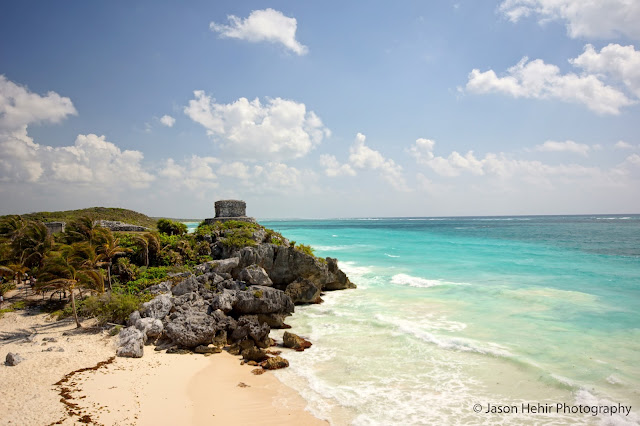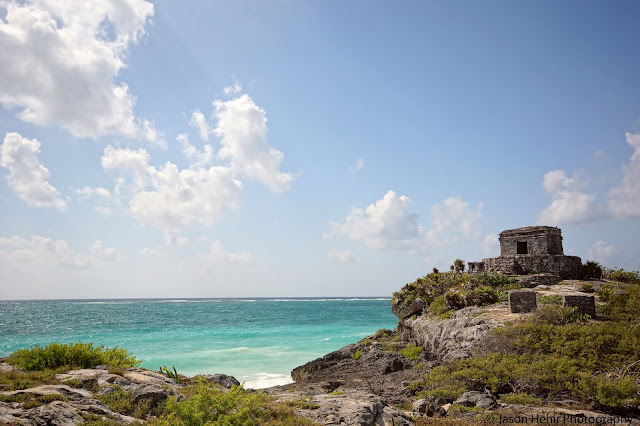It's pronounced TOO-lum. No, I hadn't heard of it either. Nice place, though; you can find it in the Yucatan peninsula on the west coast of Mexico. About half way between Cancun and the border with Belize lies this most unusual, not to mention beautiful, of sites. As you can see from the picture below it is quite popular with the tourists and this is by no means a new phenomenon established by the gringos. This was a coastal retreat of Mayan kings in the 13th century, and who could blame them. I mean look it. I have read many books on pre-Colombian America, I have watched many documentaries about it and I have scoured every last inch of the British Museum's Mexico gallery but I had never come across this jewel of a location and we basically decided we were going to come here on the strength of pictures just like these. Having arrived at Cancun airport, then, we hopped onto a couple of buses and got ourselves down the coast arriving slightly after dark.
 |
| Fancy a visit? |
Perhaps the reason that I hadn't come across Tulum was that, by Mayan standards and Mesoamerican civilisations in general, it's not a particularly important place. The buildings are quite small and they were mostly built at a time when the once great Mayan empire was in decline. There are no grand pyramids like at Chichen Itza or Teotihuacan; it wasn't a permanent seat of power like Yaxchilan or Palenque, and it's not in a geographically significant position like Tenochtitlan, now Mexico City. Yet it's position is, essentially, why it exists at all. The main building complex straddles two headlands that form a cove about 100 yards wide. The volcanic basalt cliffs embrace the golden sands as if to protect them from the unknown dangers of the deep. An arrow shot from the shore there is a coral reef, the second largest in the world, that, viewed from the cliff tops, tantalisingly breaks the water's surface between the gentle white waves. This reef perhaps gives a hint as to the first function of the site; it may well have acted as a lighthouse and, indeed, there is growing archaeological evidence to suggest just that. The main building of the complex, known as El Castillo, has a novel and sophisticated lighting system that would have allowed navigation of the narrow channel between the reef and the cliffs. So Tulum was once a port that was soon appropriated by the ruling class of the time and so began it's long history as a tourist resort.
It is about a kilometre walk from the road that runs through the town of Tulum, often referred to simply as Pueblo, to the ruins on the coast. A wide gravel path has been hacked out of the jungle to allow access and as we made our way down it the heat and humidity became ever more oppressive. 35C and 95% humidity does not lend itself to so much as a gentle stroll much less lugging a heavy camera bag up and down hills. To protect the trade that went through the port the three landward sides of the complex were surrounded by a very large, very think stone wall through which two breaches have now been made on the north and south sides for the passage of tourists. This wall was 4 metres high, 8 thick, ran for over 700 metres and would have been an incredible undertaking which gives some measure of how important a trade route this was considered at the time.
 |
| This photo nicely sums up the Mexican attitude to polite notices |
As the port grew in importance this inevitably attracted a larger and more diverse set of people to the area and soon a town of more than 1,000 inhabitants had been born. More and more structures were built, residences, a commercial area; an observatory (the Mayans were accomplished astronomers and mathematicians, temples for worshipping in; and so it was that, in 1518, when Juan de Grijalva saw this mass of structures all painted red, blue and white atop the cliffs from his boat he declared that he had found the Seville of the New World. Anyone that visits Tulum will know that this is a gross exaggeration but it would still have been an imposing sight. Grijalva was leading a small expedition from Cuba under the instructions of the legendary Hernan Cortes who had set up a base from which to explore the New World; it would be he and his men that would conquer the Aztecs who controlled the interior of Mexico over the next few years.
Tulum was not put under siege or fought over with the invaders, the fall of this city was a gradual one caused by the breakdown of society that occurred as European diseases swept through the continent and decimated populations. Within 70 years of Europeans landing in the area Tulum had been abandoned to the jungle; it's only permanent residents now being the hundreds of black lizards 1-3 feet long that sun themselves on the exposed rocks. It wasn't until the first decades of the 20th century that it was put back on the map as archaelogists slowly revealed it's secrets.
All of the places and people I have mentioned in this blog will have their stories revealed over the next weeks and months. Everyone has heard of the Aztecs but not many people know the remarkable story of the collapse of this awesome empire at the hands of just a few hundred ruthless men. This was our very first port of call in Mexico and whilst, perhaps, the structures themselves were not the grandest or largest that we would see we could not have hoped for a more tranquil and beautiful beginning to our travels.


No comments:
Post a Comment